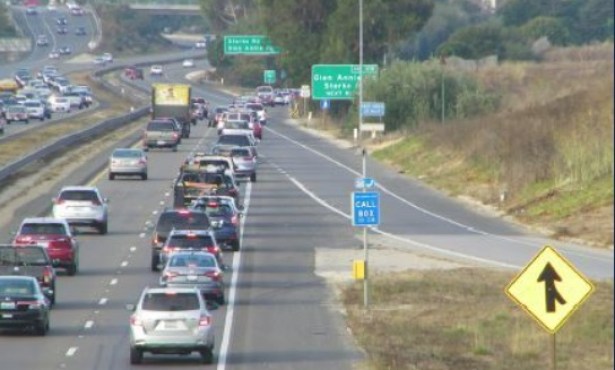Santa Barbara Council Votes to Allow 19-Unit Housing Project with No Parking Spaces
Bambi Meets Godzilla: Developer Ed St. George’s Land-Use Consultant Outfoxed Überlawyer Barry Cappello

Those expecting the City Council showdown between über-landlord and developer Ed St. George and über-barracuda, attorney Barry Cappello, to be akin to that of Godzilla and King Kong were sorely disappointed. When the dust settled late Tuesday afternoon, the outcome more resembled a battle between Godzilla and Bambi — with Cappello cast in the role of Bambi. The council voted 5-1 against Cappello and his client.
Several councilmembers did feel compelled to apologize, however, for not coming more to Cappello’s defense; they argued state and city rules that encourage — or mandate — new housing development gave them no legal leg to deny St. George’s proposal for a four-story 19-unit housing project in a small urban infill lot located at 425 Santa Barbara Street without providing a single parking space.
Councilmember Eric Friedman likened the council vote to a Jerry Seinfeld comedy routine in which Seinfeld repeatedly says, “You’re not wrong,” to someone with whom he can’t ultimately bring himself to agree. Cappello might be right, Friedman argued, but St. George had abided by all the rules laid down by City Hall and the state.
Ironically, the only councilmember to support Cappello’s arguments against the St. George project — Kristen Sneddon — also took Cappello to task for repeatedly describing the team of city planners who left her fellow councilmembers feeling boxed in as youthful housing zealots. While Sneddon termed Cappello’s remarks “offensive,” she found even more troubling his argument that the same rules and regulations that give the council no choice but to grant St. George the major density bonus needed to build his 19 housing units with no parking could equally apply to 22 downtown blocks from State Street to Milpas.
Cappello, who reminded the council he had served as City Attorney from 1971 to 1977, charged that the new development rules — some imposed by the state legislature and others willfully embraced by the council itself in response to the housing crisis — could allow the development of tens of thousands of new housing units with zero parking spaces in that zone. What are these residents supposed to do, Cappello asked mockingly, ride their bicycles everywhere? “Please, you can’t really believe that,” he asked.
Even less helpful, Cappello said, was the inadequate level of service provided by MTD, which offers neighborhood residents just one bus route delivered just once an hour. And with the city’s Cota Street parking lot about to be transformed into a new police station, Cappello added, the options that will be available to St. George’s future tenants are even more constrained.
At issue before the council this Tuesday was an appeal brought by Cappello about the approval the Architectural Board of Review (ABR) gave earlier this March to St. George’s development proposal; that approval came only after five long meetings during which they wrangled with St. George over issues of size, bulk, scale, height, interior yard setbacks, and neighborhood compatibility.
In response, St. George made several modifications, scaling back the maximum height, for example, from 48 feet to 43 feet. Even so, not everyone was happy. One commissioner — who cast the sole dissenting vote — said of the project, “Its livability and quality of life for residents is questionable, if not negligible.”
In this fight, Cappello represented an adjoining property owner, Ronald Simms, himself a heavy hitter in the world of Southern California commercial real estate and development. Simms — who, like St. George, did not speak and was not present — objected that St. George’s tenants would cannibalize the city streets for parking and that what was already a messy situation would become positively chaotic.
Councilmembers — some apologetically, others not — noted that they themselves had adopted new rules three years ago to incentivize new housing development along the Haley/Milpas corridor by no longer requiring parking spaces, among other things. They had also created new programs to allow for greater density by up-zoning that area for housing. The state legislature would enact new laws that would further up-zone the city’s initial up-zone.
Before all that, the most St. George could hope to build on the property was three units of housing. When all was said and done, the new rules allowed for a maximum of 21. He ultimately opted for 19. Of those, three are below market. Of those, two are slated for very-low-income tenants, the other for moderate-income renters.
Speaking for St. George was land-use consultant Jarrett Gorin — smart and combative — who blistered Cappello for showing photographs that made the immediate neighborhood look like a low-slung, bucolic suburbia instead of what it is: an urbanized industrial commercial zone dominated by Costco-sized structures like Smart & Final. He accused Cappello of raising arguments with the council — regarding the need for environmental review — that he’d never raised during the five long ABR hearings.
Of all the councilmembers, the least apologetic in voting to deny Cappello’s appeal was Mike Jordan. Jordan pointedly noted that he was the third of five generations of Jordans lucky enough to occupy his Mesa home. He worried about his children, he said, and about his grandkids too. Where would they live? Only Councilmember Sneddon voted to uphold the appeal, expressing concern over the wall-to-wall canyonization of the downtown corridor Cappello predicted. The rest sounded much like councilmember Friedman, who would say to Cappello, “You’re not wrong,” before voting against him.
For his part, Cappello didn’t threaten to sue City Hall. But he made a point of not saying he wouldn’t either.



